Aftermath of the Lick Fire: What to Expect
Lee Dittmann
The good news for those concerned about the impact of the massive September 2007 Lick Fire on the vegetation of Coe Park is that it will recover — in some manner. The rate of recovery, however, is highly variable among different vegetation types. Having gained some familiarity with Coe's vegetation and flora through field studies in the 90s and earlier, and having observed post-burn recovery at Coe and in a number of similar habitats elsewhere, I'm in a comfortable position to make some predictions. In brief, grasslands will recover quickest, chaparral in a few years, riparian sections somewhat longer, but some forested areas may take decades.
Chaparral
The recovery of a chaparral fire is particularly exciting to a botanist, because it is so dramatic — the same kind of experience as witnessing a caterpillar turn into a butterfly. It will be evident to most visitors that a fire has gone through.
Chaparral is not a species of shrub, but a plant community characterized by shrubby species adapted to usually poor soils, hot and dry summers, and adaptation to fire.
The most common chaparral species at Coe and in the Lick Fire burn area is Chamise (Adenostoma fasciculatum). Chamise has small, narrow leaves in fascicles (bundles) which are heavily coated to retain moisture, but which are also highly volatile. One might wonder why natural selection would favor the inclusion of more highly flammable materials in the structure of a plant growing in fire-prone areas. The answer may be that the faster the fire rages through a stand of shrubs, the less likely the fire is going to sterilize the soil. Indeed, the only places I've noticed in burn areas which lack new growth after fires are the spots where tree trunks have smoldered for days. That doesn't happen in chaparral. The fire burns hot and quick and then the fuel is gone.
Chamise has two strategies for recovery: resprouting and seed germination. The roots, little scorched by the quick burning fire, store abundant supplies of energy and in addition, form a burl at the crown, a knotty, gnarl of wood at the base of the plant that enlarges with time and, apparently, with each fire the shrub has experienced. From the burl, new green growth will emerge in weeks, even if there is little or no rain. In the first year, you can expect that these new stems will be one to two feet high, probably depending on rainfall and the fertility of the soil. In four years, most of the burnt stems of the Chamise will have been hidden by the new growth, and many visitors will not notice the continued presence of charcoal stems. Note that while stump sprouting occurs abundantly in Chamise after a fire, it does not need a fire to stump sprout. You can achieve the same result by lopping off all the stems down to the base.
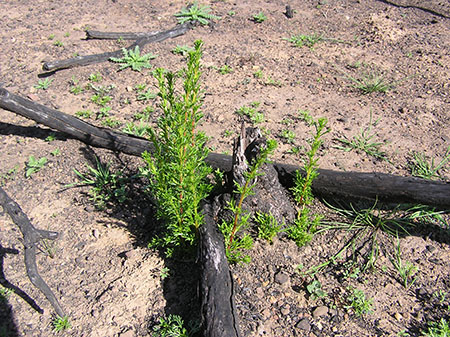
Stump sprouting chamise on Center Flats Road
Seed germination in Chamise, on the other hand, is completely dependent on fire. Seeds will lay dormant in the soil for years, probably decades, even if a stand of Chamise is opened up by, say, a new road or a new trail. By the spring after the 1993 prescribed burn on the China Hole Trail, there were thousands, probably tens of thousands of Chamise seedlings in the burn area.
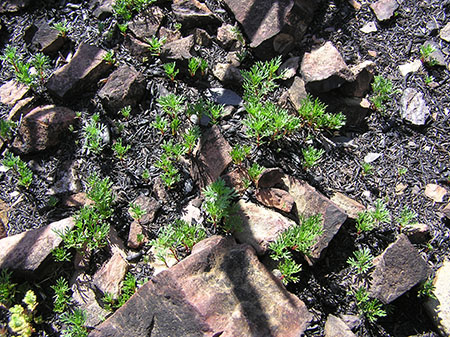
Chamise seedlings
It might happen, but I have no recollection of ever seeing a Chamise seedling outside a burn area, not a single one, which is remarkable because most species that do well after a fire will occasionally sprout in other conditions, and this leads to the second most common species in Coe's chaparral.
Buckbrush (Ceanothus cuneatus) is widespread at Coe, though there are areas of chaparral where it is absent. It also has a less common presence in open woodlands, such as along the Flat Frog Trail, and along the southern section of the China Hole Trail. Buckbrush is killed outright by fire; it does not stump-sprout after a fire. But its seeds are stimulated by fire, and sprout in abundance afterwards. In a couple of years, the new shrubs can be knee-high, and in four, many visitors will not notice that the area was ever burned. Buckbrush seeds do not require fire, however. I have spotted young plants in woodlands where no recent fires had touched. It seems that laying among the leaf mold of woodlands removes the barriers to sprouting that fire also removes. Fire, however, is apparently much more effective. I have never seen Buckbrush seedlings in unburned woodlands in any great density. Nor have I noticed them among unburned chaparral, though perhaps they are occasional. Like Chamise, if you build a trail through Buckbrush and remove it a few feet from the edge, you don't have to worry about it encroaching — until a fire comes through.
Chaparral manzanitas as a group have two strategies: resprouting from a burl and sprouting primarily from fire-stimulated seeds. To complicate things a bit, Coe's most famous manzanita species, Big-berry Manzanita (Arctostaphylos glauca), is both a chaparral species and a woodland species. In the chaparral, it rarely exceeds eight feet high, while in woodlands it is commonly fifteen feet, even higher, a multiple-trunked tree (and yes, trees can have multiple trunks). Big-berry Manzanita has thin bark and no burl, and fire kills it outright, even if it seems to be barely singed by the flames. At Coe, however, Big-berry Manzanita is only occasional within the chaparral, and not surprisingly, the seedlings which sprout in chaparral burn areas are not nearly as abundant as those of Chamise or Buckbrush. I suspect that the post-fire population size of Big-berry Manzanita shows no net gain or loss versus the abundance of other shrubby species. Like Buckbrush, Big-berry Manzanita seeds are not an obligate fire-follower. They also sprout in wooded areas without the help of fire. Indeed, the several manzanitas we planted in the 1990s at Coe Headquarters in the strip below the metal barn and opposite campsite 1 were transplanted as seedlings from the path of, or along, new wooded trails on Pine Ridge, at least some from areas that hadn't burned recently.
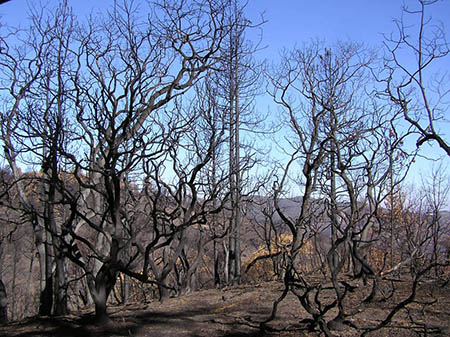
Big-berry Manzanita and Ponderosa Pine on Blue Ridge
Eastwood Manzanita (Arctostaphylos glandulosa) is less common at Coe; it has a basal burl and resprouts from that burl after a fire. The main areas within the Lick Fire boundary that I observed it occurring are on Blue Ridge, the Thomas Addition, and the north end of the Orestimba Wilderness. Its seeds might also sprout more frequently after a fire, but I don't specifically recall seeing a seedling of this species anywhere at Coe.
Manzanitas can hybridize, and one such curiosity revealed its true identity after the China Hole burn. Big-berry Manzanitas don't stump sprout, but we seemed to have one such sprouting from a burl a few feet from the new China Hole Trail. Closer inspection showed that the leaves were more characteristic of Eastwood, though having some of the pallor of Big-berry; the shrub had a more erect habit of Big-berry, which in the chaparral tends to be about as high as wide (Eastwood is usually much wider than high); but it had the burl of Eastwood, hence it's survival after the fire.

Stump sprouting Eastwood manzanita on Blue Ridge
Other shrub species that are occasional in the Coe chaparral include Toyon (Heteromeles arbutifolia), Blue Elderberry (Sambucus mexicana), honeysuckle (Lonicera spp.), gooseberry (Ribes spp.), Chaparral Currant (Ribes malvaceum), California Sagebrush (Artemisia californica), Coyote Brush (Baccharis pilularis), Yerba Santa (Eriodictyon californicum), Scrub Oak (Quercus berberidifolia) and a number of others. These will all sprout from the roots and remaining stems, which is more the norm for Coe chaparral plants than the outright death of Buckbrush and Big-berry Manzanita.
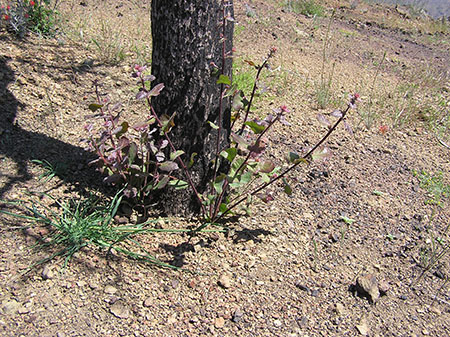
Sprouting at the base of a badly burned Oak
Of particular interest to me is the small population of Chaparral Pea (Pickeringia montana) which occurs along one of the spur roads at the park boundary north of Mt Sizer leading to the Laurel Springs Gun Club. This species also sprouts from the roots vigorously after a fire, but the seeds apparently always have a low viability, even after a fire. As all the plants I saw seemed to be within a few feet of the dirt road, and as this road might have been dozed wider as a firebreak, what will the effects be? Will there be more top growth than before, stimulated by fire and with less surrounding competition? Will the bulldozers have destroyed part, even all, of the population? Or will the roots survive being moved by the blade and even have been spread by the dozers? There might have been other, undiscovered populations of this species in the park that the fire will make it easier to find for a few years.
The most exciting thing to botanists about chaparral recovery are the fire-following herbs and subshrubs, annual and perennial. The most showy and abundant species after the China Hole burn was Whispering Bells (Emmenanthe penduliflora). This species was not present in the area before the burn — except as seeds, which apparently had lain dormant for as long as 90 years, when the last known fire had come through.

Whispering Bells sprouting on Center Flats Road 3/23/2008
The spring after, it was abundant along the upper parts of the chaparral, taking advantage of the lack of competition from shrubs to display its pendulous greenish-yellow flowers. The next spring it was still present, but in lower numbers, and by the third spring after the fire it was rare or absent. The chaparral areas burned in the Lick Fire have significantly different elevations, exposures, temperatures and rainfall, so don't expect Whispering Bells everywhere. — (1)

Whispering Bells beginning to bloom on Pacheco Ridge 04/09/2008
The area between Willow Ridge, Bear Mountain Road, and Mississippi Lake had occasional Golden Eardrops (Dicentra chrysantha) in and along the road, the seeds probably being stimulated to germinate from road grading; it is a known fire-follower, and could produce some excellent displays in this region. (In the China Hole burn area, I found only one single individual; I wonder if the time between burns was so great that seeds of this species lost their viability?) — (2)
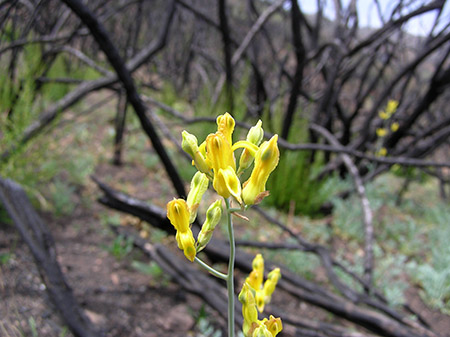
Golden Eardrops seedlings blooming near Willow Ridge Road 05/23/2008
The subshrub Sun-rose (Helianthemum scoparium) was not known from the area of the China Hole burn before the fire, but became abundant in a few places afterwards, sprouting from seed. It probably persists so long as it is not overshadowed by large shrubs (some of the areas it came up had been densely overshadowed by shrubs six feet high or more). Expect it to be common in certain recently burned areas such as Pacheco Ridge.
There are a number of other annual and perennial plants which show up in burned chaparral areas, but which are not particularly dependent on either heat or chemical effects of fire (even though stimulated by same), rather are more opportunistic in exploiting the new availability of light and space. These are plants which appear along trailsides of unburned chaparral, and include various species of Lotus — including the subshrub Deerweed (Lotus scoparius) as well as low annual lotus — clovers (Trifolium spp.), dwarf primroses (Camissonia spp.), Pygmy Stonecrop (Crassula connata), and numerous composites.
Some plants which appear to be fire-followers are not really — those which are sometimes called geophytes ("earth plants"), since they die back to and arise from underground storage organs — bulbs, corms, tubers — each year. One such is Fremont's Star-lily, (Zigadenus fremontii). It has been noted to be blooming in profusion among burned Chamise in March of 2008, seemingly where it was not growing before. Except that this plant is a perennial geophyte, and it takes many years of growth before these plants reach blooming size from seed — so its corms were present before the fire. Didn't notice them before? How often does anyone stroll through the middle of dense chaparral? I suspect that one way or the other, fire stimulated the bloom (whether from heat, improved light, and/or released nutrients from grey ash), but almost certainly all of the zigedene blooming were already growing beneath the Chamise shrubs, none merely resting dormant as seeds. — (3)
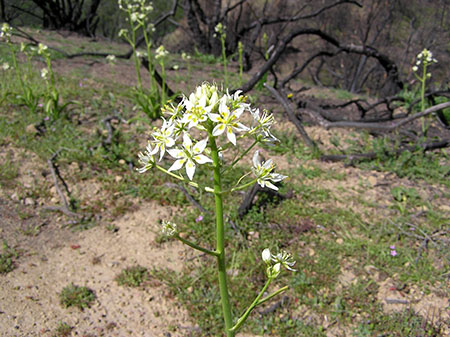
Zigadenus fremontii
Although they prefer full sun, star-lilies are shade-tolerant so survive in the filtered light of a Chamise canopy. Most of the places that I've recorded them growing at Coe are in and along cuts in chaparral for roads and trails. That I didn't record them from deep within the chaparral is readily explained by the fact that I did not venture within it very often, particularly early in the blooming season when it flowers. But when we cut the rerouted China Hole Trail through chaparral in the 90s, we did find star-lily in parts of it that we wouldn't have been aware of otherwise. (Star-lily is not, however, restricted to chaparral.) Though an increase of flowering stalks in star-lily may be an effect of fire, the presence of the plants themselves in a burn area is not — in contrast to Whispering Bells which was present only as long-dormant seeds prior to a fire.

Bloomeria crocea — another geophyte — blooms vigorously after a fire
Similarly, California Manroot or Wild Cucumber (Marah fabaceus) has been observed growing in profusion in parts of the burn area, but it is also a perennial, which has herbaceous vinous stems which resprout annually from a large underground tuber.

Wild Cucumber
Before the fire, the vines climbed to the light through the network of chaparral stems in winter and spring, sometimes almost smothering the shrubs on which they were supported, before the leaves and stems shrivel to a mere trace by early summer. After a fire, they are all the more conspicuous spreading over the ashy ground with little or nothing to attach their tendrils to.

Wild Cucumber covers the ground in burned areas
Grasslands
Open grasslands were not very common in the burn area; the most significant ones were on the Thomas Addition, parts of Rock House Ridge, the upper parts of Miller Field (the lower parts appear not to have burned), and Paradise Flat. This will be the quickest community to recover, and after one winter and spring's growth, most laypeople probably won't notice that a fire had been through. The more discerning will notice the presence of ash around the bases of the new grass and wildflowers, but I suspect that by summer of 2008, some visitors will notice burned forests and chaparral in the background and suppose that the fire didn't reach the grassy areas. The native perennial grasses (e.g. Nasella spp. and Elymus glaucus) probably do better after a fire than some of the alien species such as oat (Avena spp.). It is not clear to me that all alien species dislike burned areas, so I make no predictions as to whether the burned grasslands will end up with a net increase of coverage of native species versus aliens. In the 1993 China Hole prescribed burn, oats grew abundantly in some areas, and began to invade the areas of Chamise chaparral at the margins. (I think that eventually the Chamise must have out competed it; plus small mammals which live in the transition area between grassland and chaparral often eat up all the low herbs including grasses.)
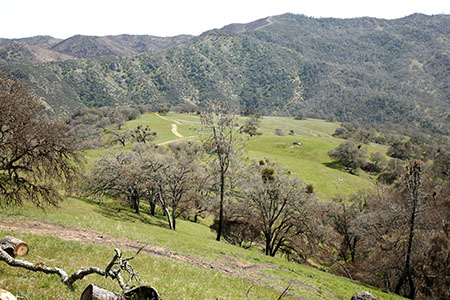
March 2008 - Evidence of fire already hard to see in burned portions of Miller Field
Perennial species already present in the grasslands, such as shooting star (Dodecatheon spp.), Yellow Pansy (Viola pedunculata), Ground Iris (Iris macrosiphon), and the iris-relation California Blue-eyed-grass (Sisyrhinchium bellum), certainly appear more showy after a fire with the grass all burned off, but whether they actually increase in abundance, I don't know.

March 2008 - Bear Mt. Road Along the East Fork of the Coyote Creek
Riparian
The riparian zone consists of plants restricted to wet creeksides and at springs, and have a very limited distribution within the burn area. Coe's best developed riparian areas, Coyote Creek and its Middle Fork, were mostly not within the burn area — the upper parts of the Middle Fork within the burned Thomas Addition not being very riparian. The signature plants of the riparian zone, such as willows (Salix spp.), tend to grow quite vigorously with or without a burn, and any that were scorched can be expected to recover within a few years. If we include the emergent aquatic and semi-aquatic plants that grow along streams and reservoirs of Coe, such as cattails (Typha spp.) and bulrush (Scirpus sp.), any of these that were burned can be expected to recover within one growing season. Though fully-aquatic species, such as the pondweeds (Potamogeton spp.) and Water Buttercup (Ranunculus aquatilis), of course, don't burn, could the increased amount of ash running off into the ponds affect their growth?
Forests
I'll use the term "forests" here in a loose sense, meaning any assemblage of trees rather than forest trees in the narrow sense, of which Coe has only Ponderosa Pines (Pinus ponderosa), and these only rarely in dense enough assemblages to be worthy of the "forests" moniker sensu strictu. The more inclusive term "woodland" is too inclusive for our purposes: it also includes the chaparral. The tree-dominated communities of Coe will be the slowest to recover, and in some cases might not recover at all. Coe's ponderosas, probably relicts of a much wider distribution during the last Ice Age, are of greatest concern.
Many fine specimens grew along the crest and on the northeast-facing slopes of Blue Ridge, an area all burned. As the road along the crest of Blue Ridge was one of the firelines for holding the fire, it is possible that most of the flames that blazed among the pines there were low-intensity backfires set by the crews to remove the fuel before the advancing wildfire could reach the trees and set alight their crowns. Even so, ponderosas untouched by fire in the crowns could still die. Even in low intensity prescribed burns such as took place around, north, and west of the Monument on Pine Ridge in the 90s, the scorching of needles and bark can put enough stress on a pine to make it more vulnerable to insect attack, for instance — especially if the winter rains are lower than average. The needles of pines which look little touched immediately after the fire turn brown and drop off from lower branches over subsequent weeks.

Fire damaged Ponderosa Pines on Blue Ridge Road
But what about seed regeneration of ponderosas? Won't it be better after a fire? Contrary to a statement in the San Jose Mercury in discussions about the Lick Fire, Ponderosa Pines do not need fire to open the cones to release the seeds. The cones will eventually open in warm weather, anyway, and the seeds are also distributed when they fall from the tree. (Closed-cone pine cones, especially the Knobcone Pine (Pinus attenuata) over in the Santa Cruz Mountains, don't seem to open until a fire, and can remain unopened on the branches for years.)
But fire can certainly improve the seed bed, releasing nitrogen from accumulated wood and other plant debris. You may well see a good crop of seedlings on Blue Ridge by this spring. But how long will they survive? You need a wet year for the seedling to grow fast enough that it can get its roots down deep and survive the normal dry summers. Most will perish in the first summer. They need a series of normal to wet years to enable them to be able to survive future dry years. Then they will need to grow to sufficient height with sufficient bark thickness to survive the next fire, prescribed or otherwise. How long does that take? I would suggest a minimum of ten years, twenty to thirty more likely.
To give you an idea of how slow early growth is for a wild ponderosa, let me refer you to the campground tree-planting project initiated in 1992 under my direction, and assisted by Chris Weske and a number of other volunteers. All of the surviving ponderosas in the campground were transplanted seedlings, and more about them shortly. But I also planted, as an experiment, several ponderosa seeds directly into a prepared bed near campsite 13. As I recall, three sprouted, but all but one died in the first season. Though mulched, shaded from the summer sun, given deep soaking irrigation in the summer, after three years the survivor was only about four inches high to the top of the needles, with only a few bundles of needles to demonstrate its transition from the early seed leaves. The successful transplantees, on the other hand, were in the five to seven inch range when first moved with relatively abundant bundles of needles. Since they had been growing at the top of Pine Ridge in wild conditions (i.e. no summer watering, some probably competing with roots from larger trees) they can be supposed to have been much older. A five or six-inch wild ponderosa at Coe could easily be five or more years old! I dug up about fifteen in this size range before a scheduled prescribed burn, but left many others. After the burn, I couldn't find a single survivor among the little ones left behind.)
From what I've seen from the growth of the pines in the campground, when they begin to branch out, they usually don't put out more than one whorl of branches per year, and from this I deduce that in the early years of growth, wild Coe ponderosas tend to grow only a few inches per year after the seedling stage, and it isn't until they get to chest or head height that they may begin to grow by a foot or more annually. (Since I pampered the Coe campground pines with deep summer waterings for the first six years of being planted out, they grew faster.) If we suppose that a ponderosa needs to be a minimum of six feet to survive a grass/needle fire (and I noticed pines of about that size and smaller destroyed in prescribed burns), then my estimate of a minimum of ten years of age sounds very conservative, and the twenty all the more likely. And maybe they need to be larger still, and older still.
The upshot is that even if this winter's seedling crop of ponderosas is good, the chances of any surviving to maturity are slim. On the other hand, if an average Coe ponderosa lives a hundred years (only an estimate, I don't know of any definitive age studies done at Coe), then only one seedling per hundred years has to survive to maturity for the population to be maintained. But that could also mean that for the next seventy or so years, the ponderosas on Blue Ridge are sparser!
Remember that as a relictual presence, ponderosas are at the edge of their range in Coe Park. While a gardener can certainly grow a Ponderosa Pine well outside its range, that is only because it has been nursed through its vulnerable early years. Conditions for a wild tree have to be right throughout its life cycle, not merely from sapling-size on. If the right conditions had been occurring at Coe more frequently, the range would be spreading, and you would see numerous young trees advancing beyond the shadow of the matriarchs. I've seen no evidence for this, rather reproduction at replacement numbers at best (like around the Monument), and declining range in some locations (I remember few or no young trees at the north end of Blue Ridge). If the climate is getting only a little drier on average, that could mean the further decline of ponderosas at Coe.
The survival of Gray Pines (Pinus sabiniana) at Coe after the Lick Fire is of no serious concern. I doubt if any that had crown fires will survive, and as they sometimes grow near and among chaparral shrubs (such as at Hat Rock), I imagine many became torches. But though, like ponderosas, the cones of Gray Pine, don't need fire to open, the seeds are larger than those of the ponderosa and thus the seedlings have more vigorous growth. The tree is also more drought tolerant and more shade tolerant. While few large Gray Pines might have survived in the burn area, in a decade there could be numerous significant replacements.
On the other hand, to illustrate the complexity of the situation, let's consider this: What if, because other food sources are scarce, the highly edible seeds become more sought after and consumed by wildlife? Pine seeds are not like seeds embedded in berries: the latter consumed and excreted without harm to the seed; when eaten, pine seeds are done for as seeds. On the other hand still, small mammals such as rodents which survived the fire by finding refuge in underground burrows might cache large quantities of the seeds for future foods, and some might sprout before consumption. (Snakes might find the rodents easier prey due to lack of cover, but then the snakes might be easier prey to raptors; it gets complicated, this prediction business!) But all-in-all, I expect a fairly prompt recovery of Gray Pines in the burn area, which just ooze drought-resistant hot-country vitality.
Of the park's two other known conifer species, California-nutmeg (Torreya californica) and California Juniper (Juniperus californica), I have no personal experience observing post-burn effects. The federal Fire Effects Information System (FEIS) database online states that after a fire, Torreya resprouts from the base. The only specimens I have visited at Coe were in a clump within the now burned area north of Mt Sizer; the numerous small trunks indicate to me a marked ability to sprout from roots, so I'm not at all surprised to read that FEIS confirms that. The same reference says that California Juniper is killed outright by fire, and that there is no increase in seed germination after a fire. Junipers are fairly common within parts of the burn area, in fact the majority of its range within Coe was burned. It often grows in rocky areas, and it is possible that due to lack of fuel, many survived within the burn zone. If not, there will be far fewer junipers at Coe for some time to come. Seedlings seem to need shade to survive the first few years and shade is more scarce in a burn zone. Any regeneration will come from surviving plants within the burn area and others from without, spread by mammals and birds which eat the berry-like cones then excrete the seeds.
Oak woodlands and mixed hardwoods could take years, even decades to recover, if crowns ignited, for even if there are abundant seedlings, most will die and many of the survivors will be browsed by deer and kept low for many years until conditions are such that the young trees can get above the easy browse line. Many oaks (Quercus spp.) that resprout from the trunks and branches may die after a few years. However, I predict that the oaks and other hardwoods — e.g. Pacific Madrone (Arbutus menziesii) and California Laurel or Bay (Umbellularia californica) will recover from the fire more quickly than the conifers since they are not at the edge of their range, and are simply more resilient than the more ancient lineages of conifers .
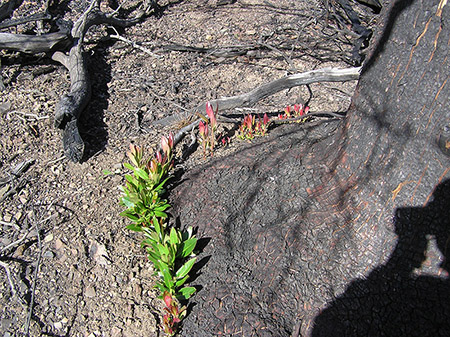
Stump sprouting Madrone
Fire equipment
Most of the article above was written in September before the fire was fully contained. At that time, I predicted that the greatest adverse effect on the Coe environment from the Lick Fire would be from fire fighting equipment, particularly bulldozers. They often cut lines on open ridges which are subject to severe erosion. Further, fire equipment brought in from other areas can spread seeds of non-native species, and 'dozer cuts can provide ideal seed beds for such species, as well as spreading existing alien plants. Adverse effects are relative, and I still assert that, since the native environment is adapted to fire, fire equipment activity is probably the greatest adverse effect associated with the fire. (I believe that the greatest overall recent adverse human effect on the native Coe ecosystem — not counting the extinction of grizzly bears, and some overgrazing activity before our time — was the construction of the fire and ranch road network throughout the region of the park, because of continuing erosion from poor design and maintenance.) Given the situation, it was a necessary action, since letting the fire burn itself to the edge of developed areas was not an option.
Robert Patrie, who had assisted George Gray in developing a fire-management plan for Coe before the Lick Fire, assures me that great care was taken by CalFire in combating the Lick Fire. Heavy equipment use was largely limited to existing park roads and trails (Blue Ridge Road, Poverty Flat Road, Kaiser Aetna Road, Center Flats Road, County Line Road, Scherrer Trail, Crest Trail, Divide Ridge Road, and Orestimba Creek Road). Large back-fires rather than heavy equipment were used to contain the burn. Some damage was done by bulldozers on the lower end of Willow Ridge Trail, in the Upper San Antonio Valley, and in the creation of a number of safety zones which were cleared to provide places of refuge for firefighters, but heavy equipment damage was kept to a minimum. And I was favorably impressed by statements made by State Parks people, assuring the public that while the aftermath may look bad, the long term effect of the actual fire will be positive, with no call for massive revegetation projects. — (4)
This is why prescribed burns are generally better for the environment — and certainly much safer. You don't have to cut lines with a bulldozer in a hurry to get in front of the flames, and you plan your burn to take advantage of existing roads. New fire breaks are cut by hand and are minimal width, since you can wait to ignite when the breeze will lead the fire into the prescribed burn area, widening your firebreak. If the conditions are not cooperating, you don't ignite. Prescribed burns tend to be conducted when it is safest to keep the fire within the designated area. The 1993 China Hole burn, for example, was initiated in early November, after the first substantial rain. This made little or no difference to the fire through the chaparral: observers estimated flame height as much as 100 feet. But once the fire hit the woodlands, it quickly reverted to a low undergrowth fire and even fizzled out, the humidity was so high. (In fact, they had to reschedule a burn for the woodlands later when it was drier.)
On the other hand, wildfires of non-human origin are started by lightning, and lightning at Coe, fairly uncommon any time, is more of a summer phenomenon. If one purpose of a burn is to replicate the fire regime existing before human intervention, the Lick Fire was timed better than your typical prescribed fire. Even though it was caused by a mistake of one of the Coe Park neighbors, it is quite possible that a lightning-ignited fire could have occurred at the same time of year — accompanied by too little rain and humidity to slow it down.
The human residents of California's hills and mountains and those who live in the valleys nearby should be aware that they are living in an area that has evolved with fire, or, as some would put it, is made to burn. Your management choices for these wildlands are realistically limited to two options: You suppress fires as much as possible, until such time the fuel load is so large that despite the best efforts of firefighters, you get catastrophic wildfires on a schedule you don't choose and at huge costs, including, often, the lives of firefighters and rural residents. Or, you conduct frequent prescribed fires at much lower cost, at a more convenient and safer time, and with low risk of injury. The latter can certainly produce irritating and unhealthy levels of smoke in surrounding communities, but, like earthquake risk, is one of the costs of living in the Golden State.
|
Footnotes:
(1) As of late April 2008, E. penduliflora has been seen in almost all the burned chamise areas along Center Flats Road, Pacheco Ridge Road and along County Line Road from Kaiser-Aetna Road to Bear Mountain Road. It has also been found on Bear Mountain Road, Blue Ridge, the Thomas Addition and along Orestimba Creek, Robison Creek and Red Creek. In some places, it is the predominant plant sprouting in areas of burned chamise. Whispering Bells may sound like an odd name for this fire-follower, but when the little bell-shaped flowers dry out, they don't drop. They stay on the stems, and it is then that they shake against each other and whisper in the wind.
———
(2) Populations of Dicentra chrysantha, a perennial plant, have been found in burned areas on Booze lake Road, Bear Mt. Road, Willow Ridge Road and near Robison Falls. Some plants continued to bloom well into October, 2008
———
(3) There is a relevant article in the Fall 2007 issue of Fremontia: Journal of the California Native Plant Society. — Chaparral Geophytes: Fire and Flowers — by Claudia M. Tyler and Mark I. Borchert describes the authors' field studies, much of which focused on Fremont's star-lily. They report the plants grew more vigorously in unburned chaparral, but rarely bloomed and set seed. Fire induced massive flowering and seed production, just as is being seen at Coe, but at the expense of stored reserves; individual plants actually grew less the following year.
———
(4) This in contrast to the US Forest Service a few decades ago, reacting after the Marble-Cone Fire in Monterey County circa 1977, which burned an area of much greater size mostly in the Ventana Wilderness. The Forest Service went to great expense to seed parts of the burn area with non-native ryegrass, apparently in response to public outcry to — do something. — I followed the post-burn studies of the late Hastings Reservation ecologist James Griffin, who noted that in some areas, the heavy growth of ryegrass choked out or impeded recovery of native species which were doing quite well after the fire.
|
---
Lee Dittmann was a resident volunteer and/or staff member at Coe Park for over nine years and studied the flora of the park for parts of that time. He has created and maintains the unofficial Coe website:
http://www.coestatepark.com .
Photographs by Bob Patrie and Ron Fischler
|

















